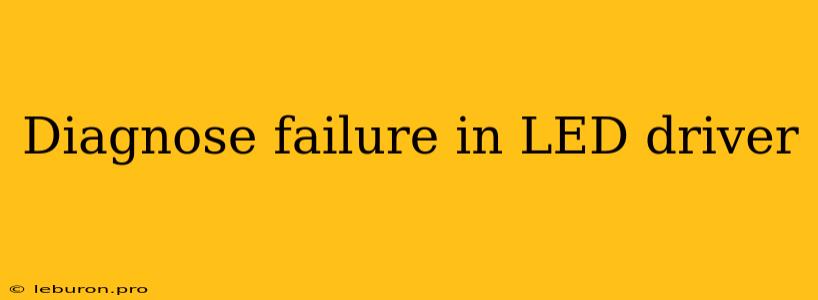LED drivers are essential components in any LED lighting system, providing the necessary power and control for the LEDs to function optimally. However, like any electronic device, LED drivers can experience failures, leading to malfunctioning lights, flickering, or complete darkness. Diagnosing the cause of failure in an LED driver can be a challenging task, requiring a systematic approach and understanding of the various components and their functions. This article will delve into common LED driver failure modes, provide practical tips for diagnosing the issue, and offer insights into troubleshooting strategies to help you effectively resolve problems related to LED driver failures.
Understanding LED Driver Failure Modes
LED drivers can fail for various reasons, and understanding the common failure modes is crucial for accurate diagnosis. Here are some of the most prevalent scenarios:
1. Power Supply Failure:
- Overvoltage: Exposing the driver to excessive voltage can damage its internal components, leading to a complete shutdown.
- Under-voltage: Insufficient voltage can cause the driver to operate erratically or fail to start.
- Short Circuit: A short circuit within the driver or in the LED circuit can result in high current draw, damaging the driver's components.
2. Output Failure:
- Open Circuit: An open circuit in the output circuitry prevents power from reaching the LEDs, causing them to be completely off.
- Short Circuit: A short circuit in the output circuitry can lead to overheating and damage to the driver or the LEDs.
- Overcurrent Protection: If the driver detects excessive current draw, it may shut down to protect itself and the LEDs.
3. Control Circuit Failure:
- Dimming Malfunction: Issues with the dimming control circuit can lead to inconsistent dimming levels or complete failure of dimming functionality.
- Timer Failure: A malfunctioning timer may cause the LED lights to turn on or off unexpectedly.
- Remote Control Failure: A malfunctioning remote control can prevent the user from controlling the LEDs.
Diagnosing LED Driver Failure
Once you've identified that an LED driver is failing, it's essential to diagnose the specific cause to implement the appropriate troubleshooting strategies. Here are some steps to help you pinpoint the problem:
1. Visual Inspection:
- Look for signs of overheating: Check the driver for any signs of burning, discoloration, or excessive heat.
- Inspect the wiring: Examine the wiring for any loose connections, damage, or corrosion.
- Check the LEDs: Inspect the LEDs for any signs of failure, such as flickering, dimness, or complete burnout.
2. Electrical Testing:
- Measure the input voltage: Verify that the input voltage to the driver is within the specified range.
- Measure the output voltage: Check the output voltage to ensure it's correct for the LEDs.
- Measure the current draw: Determine if the current draw is within the driver's specifications.
- Use a multimeter: A multimeter can be a valuable tool for measuring voltage, current, and resistance.
3. Troubleshooting Steps:
- Isolate the problem: Disconnect the LED driver and test it with a known good power source. If it works, the problem may be with the wiring or LEDs.
- Replace components: If you identify a faulty component, such as a fuse or capacitor, replace it with a new one.
- Check for compatibility: Ensure that the LED driver is compatible with the type of LEDs you are using.
Tips for Preventing LED Driver Failure
While it's impossible to completely prevent LED driver failure, you can take several steps to minimize the risk:
- Use high-quality drivers: Choose LED drivers from reputable manufacturers with proven reliability.
- Install properly: Ensure that the driver is installed correctly and securely, following manufacturer instructions.
- Provide adequate ventilation: Ensure proper ventilation to prevent overheating, which can contribute to premature failure.
- Avoid overloading: Do not exceed the driver's rated output power.
- Regular inspection: Perform regular inspections of the driver and LED system to identify any potential issues.
Conclusion
Diagnosing LED driver failure can be challenging but manageable with a systematic approach. By understanding common failure modes, performing thorough inspections, and using appropriate electrical testing, you can effectively identify the root cause of the problem. Implementing preventive measures can also significantly reduce the risk of failures and ensure the longevity of your LED lighting system. Remember to consult a qualified electrician if you are unsure about any of the procedures or if you suspect a serious electrical issue.
